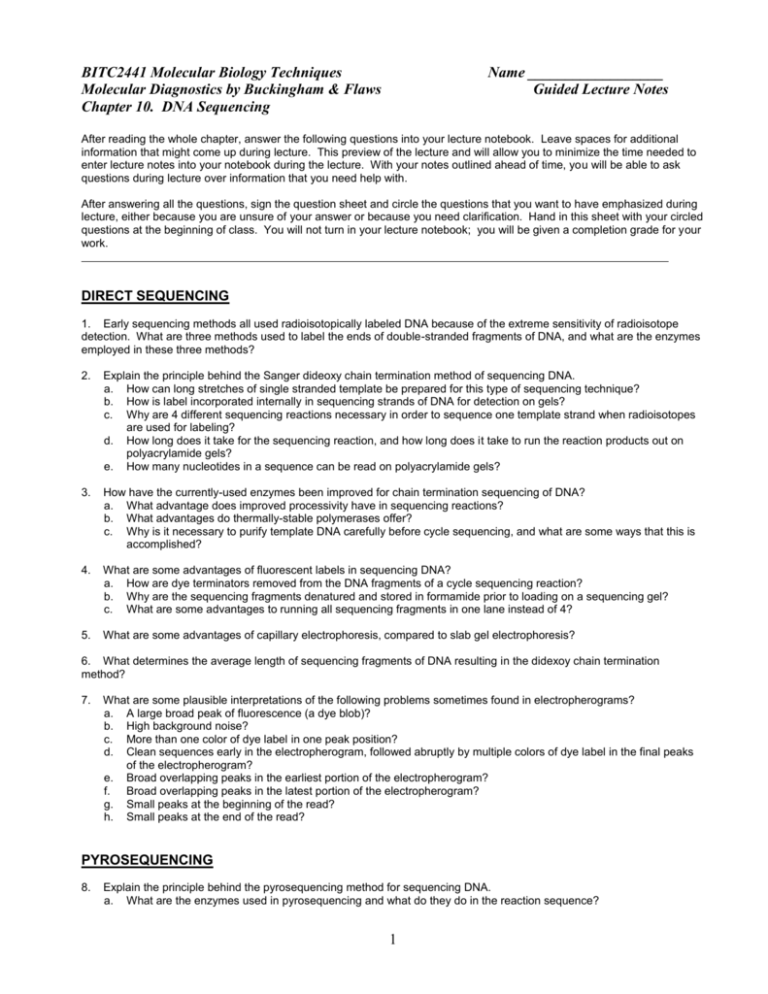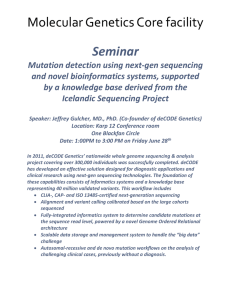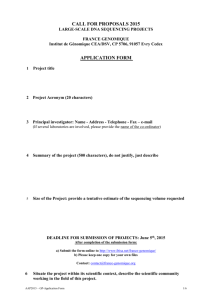Phelps, Patricia OH
advertisement

BITC2441 Molecular Biology Techniques Molecular Diagnostics by Buckingham & Flaws Chapter 10. DNA Sequencing Name __________________ Guided Lecture Notes After reading the whole chapter, answer the following questions into your lecture notebook. Leave spaces for additional information that might come up during lecture. This preview of the lecture and will allow you to minimize the time needed to enter lecture notes into your notebook during the lecture. With your notes outlined ahead of time, you will be able to ask questions during lecture over information that you need help with. After answering all the questions, sign the question sheet and circle the questions that you want to have emphasized during lecture, either because you are unsure of your answer or because you need clarification. Hand in this sheet with your circled questions at the beginning of class. You will not turn in your lecture notebook; you will be given a completion grade for your work. DIRECT SEQUENCING 1. Early sequencing methods all used radioisotopically labeled DNA because of the extreme sensitivity of radioisotope detection. What are three methods used to label the ends of double-stranded fragments of DNA, and what are the enzymes employed in these three methods? 2. Explain the principle behind the Sanger dideoxy chain termination method of sequencing DNA. a. How can long stretches of single stranded template be prepared for this type of sequencing technique? b. How is label incorporated internally in sequencing strands of DNA for detection on gels? c. Why are 4 different sequencing reactions necessary in order to sequence one template strand when radioisotopes are used for labeling? d. How long does it take for the sequencing reaction, and how long does it take to run the reaction products out on polyacrylamide gels? e. How many nucleotides in a sequence can be read on polyacrylamide gels? 3. How have the currently-used enzymes been improved for chain termination sequencing of DNA? a. What advantage does improved processivity have in sequencing reactions? b. What advantages do thermally-stable polymerases offer? c. Why is it necessary to purify template DNA carefully before cycle sequencing, and what are some ways that this is accomplished? 4. What are some advantages of fluorescent labels in sequencing DNA? a. How are dye terminators removed from the DNA fragments of a cycle sequencing reaction? b. Why are the sequencing fragments denatured and stored in formamide prior to loading on a sequencing gel? c. What are some advantages to running all sequencing fragments in one lane instead of 4? 5. What are some advantages of capillary electrophoresis, compared to slab gel electrophoresis? 6. What determines the average length of sequencing fragments of DNA resulting in the didexoy chain termination method? 7. What are some plausible interpretations of the following problems sometimes found in electropherograms? a. A large broad peak of fluorescence (a dye blob)? b. High background noise? c. More than one color of dye label in one peak position? d. Clean sequences early in the electropherogram, followed abruptly by multiple colors of dye label in the final peaks of the electropherogram? e. Broad overlapping peaks in the earliest portion of the electropherogram? f. Broad overlapping peaks in the latest portion of the electropherogram? g. Small peaks at the beginning of the read? h. Small peaks at the end of the read? PYROSEQUENCING 8. Explain the principle behind the pyrosequencing method for sequencing DNA. a. What are the enzymes used in pyrosequencing and what do they do in the reaction sequence? 1 b. c. d. What is the detector used in pyrosequencing? How can ssDNA template be prepared for pyrosequencing? What are the limitations and applications of pyrosequencing in the molecular lab? BISULFITE DNA SEQUENCING 9. Explain the principle behind the bisulfite method of sequencing DNA. a. What are the enzymes used in bisulfite sequencing and what necessary role do their reactions play in this sequencing method? b. What role does bisulfite play in this method of sequencing DNA? 10. What other methods are used to detect methylation of specific DNA sequences? BIOINFORMATICS 11. What is the difference between computational biology and bioinformatics? 12. How has the IUPAC and IUB provided standardization in the field of bioinformatics? a. Explain the mnemonics for the mixed bases symbols. b. Explain how the symbols for mixed bases are used in the identification of consensus sequences. THE HUMAN GENOME PROJECT 13. Which genome was the first to be completely sequenced, how long was it, and in what year was this accomplished? 14. Why was the DOE involved in the Human Genome Project (HGP) from the start? a. What were some technological advances that allow such a large project to be accomplished? b. What important roles did BLAST and GRAIL play in the archiving of data from the HGP? 15. Whose DNA was actually sequenced by the HGP? a. When did the HGP actually begin, and when did Celera announce its own sequencing project? b. When Celera announced its own HGP, when did it propose as its completion date? What effect did this have on the work being done by the public consortium? Why did the public consortium feel it needed to respond to Celera’s competitive claims? c. Explain the differences between the NIH approach (hierarchical shotgun sequencing) and the Celera approach (whole genome shotgun sequencing) in the HGP. What are the strengths and weakness of each approach? d. When did the two sequencing project complete the rough draft of the human genome sequence? e. What is the difference between the rough and the finished draft of genome sequences? f. When was the full sequence completed on the last chromosome, and which chromosome was it? 16. What did the rough draft of the human genome reveal about its size? a. What is the average GC content of the human genome, and what variation is there between the different chromosomes in GC content? b. Which are the most gene-rich chromosomes, and which chromosomes have the lowest gene density? c. What proportion of the human genome actually codes for proteins, and how much of the human genome consists of repeat sequences? d. What is a SNP and what is the approximate SNP density when comparing the DNA sequences of two unrelated individuals? 17. There were at least 7 different pharmaceutical companies that were paying $2 million dollars a year to subscribe to Celera’s sequencing data during its HGP. Explain why these companies felt that this information was that valuable. a. What is a haplotype, and what are the goals of the HapMap Project? 2 KEYWORDS haplotypes polymorphisms T4 polynucleotide kinase terminal transferase polyacrylamide dideoxynucleotide (ddNTP) chain terminator M13 bacteriophage P32 / S35 internal labeling end labeling stop buffer sequencing ladder Sequenase/Thermosequenase Therminator processivity cycle sequencing dye primer/dye terminator formamide/urea denaturing buffer capillary electrophoresis electropherogram dye blobs pyrosequencing sulfurylase luciferase adenosine-5’phosphosulfate (APS) luciferin 3 pyrophosphate apyrase bisulfite DNA sequencing hydroquinone bioinformatics/computational biology consensus sequences BLAST/GRAIL IUPAC/IUB Human Genome Project (HGP) heirarchicall/whole-genome shotgun Sequencing rough/final draft sequence HapMap Project







